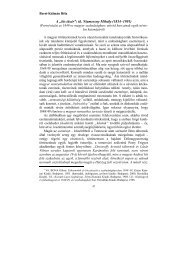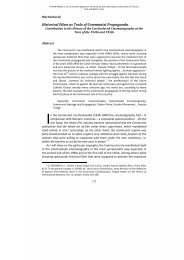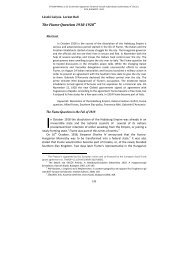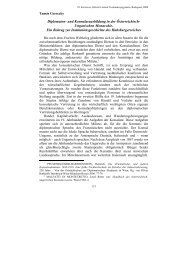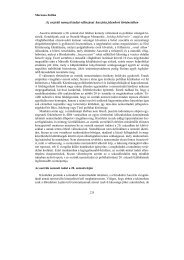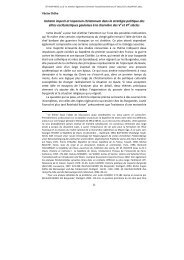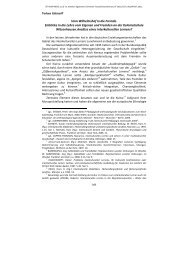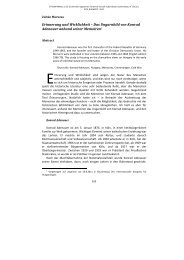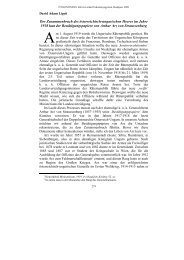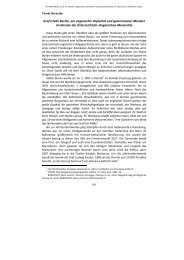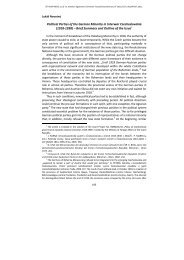The Molotov-Ribbentrop Pact - ELTE BTK Történelem Szakos Portál
The Molotov-Ribbentrop Pact - ELTE BTK Történelem Szakos Portál
The Molotov-Ribbentrop Pact - ELTE BTK Történelem Szakos Portál
Create successful ePaper yourself
Turn your PDF publications into a flip-book with our unique Google optimized e-Paper software.
expert of this matter 29 and had as a „Zionist” and „Idealist” the goal of a<br />
„political Solution of the Jewish question” in mind. 30<br />
Development of the SD<br />
<strong>The</strong> Security Service called „Sicherheitsdienst” (SD) of the SS was modeled in<br />
1931 after military aspects as section Ic. It was established of the SS-Oberstab in<br />
Munich and was led by Heydrich, who was SS-Sturmführer at that time. In 1932<br />
the section Ic had been transformed into the SD and should soon be the priority<br />
intelligence on the model of the Intelligence Service or the Deuxième Bureau.<br />
In 1935 the establishment of the SD main office in Berlin followed, which<br />
was divided into the offices I, administration and organization; II inland and III<br />
foreign countries. <strong>The</strong> intelligence analysis of the Jewish organizations began<br />
in 1935 and was for the time business of the SD department II-111<br />
„Freemasonry”. After that, the department II-112 of the SD main office took<br />
over the exploration of the Jewish organizations, through the monitoring of the<br />
Jewish press and meetings in cooperation with the Gestapo. Divided into the<br />
departments „assimilates, orthodox’ and Zionists”, files were made, diagrams<br />
produced and reports created. 31<br />
When Prof. Dr. Six overtook the main department II-1, the cooperation of<br />
the department II-112 and the Gestapo got even closer. After Mildenstein and<br />
Kuno Schröder, Dieter Wisliceny overtook the department and he forced the<br />
so-called „Zionist emigration” and the „elimination of the Jews from German<br />
economic life”. With the next head leader, Herbert Hagen, the area of work<br />
expanded. From then on files of all „important Jews” of other countries<br />
concerning policy, economics and science should be made. In doing so, special<br />
attention should have been given to Austria. Furthermore Hagen envisioned an<br />
expansion of the influence of Gestapo and SD on to the economic and financial<br />
area of the Nazi policy, which he wanted to achieve with the centralization of<br />
the „treatment of the Jewish question in Germany”. But this should only be<br />
made possible through the actions in Austria. 32<br />
<strong>The</strong> situation in Austria<br />
Meanwhile Austria respectively Vienna fell into chaos. Already in the night<br />
before the „invasion” 33 of German troops on the 12 th of March 1938, by which<br />
another about 200.000 Jews came under the sphere of influence of the Nazi<br />
29<br />
POHANKA, Reinhard: Pflichterfüller. Hitlers Helfer in der Ostmark. Wien, 1997. 37.<br />
30<br />
KNOPP: 31.<br />
31<br />
SAFRIAN, Hans: Eichmann’s Men. 16-17.<br />
32<br />
Ibid. 14-19. LEGENSTEIN, Roland: Adolf Eichmann - der Schreibtischtäter. Koordinator<br />
der „Endlösung”. Dipl.-Arb., Wien, 2002. 21-26.<br />
33<br />
This „invasion” was hailed by a very large part of the Austrian population.<br />
81



